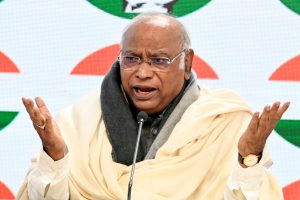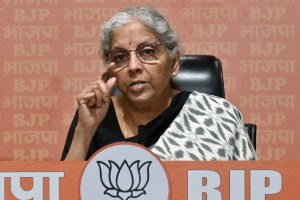When the Republic of India came into being, a large number of world class scientific institutions also emerged. Tata Institute of Fundamental Research (TIFR) in Mumbai, Saha Institute of Nuclear Physics (SINP) in Kolkata, Physical Research Laboratory (PRL) in Ahmadabad, Atomic Energy Establishment, Trombay, and the already existing Indian Institute of Science in Bengaluru, to name a few, were established in quick succession.
The country’s first Prime Minister, Jawaharlal Nehru, was the prime mover, a great visionary and an outstanding leader of men and above all a man of science and more important a pioneer of scientific temper. Five eminent personalities come readily to mind in that epoch, pre-eminently Homi Jehangir Bhabha, the chief architect of the Department of Atomic Energy, Meghnad Saha, Vikram Sarabhai, Sir C.V. Raman and of course Prasanta Chandra Mahalanobis, who put India on the world map of statistics.
The dynamism of Homi Bhabha with his incredible vitality put India on the world map of atomic energy and fundamental science, rather rapidly. These institutions were at par with the world’s best. Proximity to the Prime Minister cut through the red tape with remarkable speed. Major decisions were taken just by exchanging letters without falling back on the “file culture”. There was considerable interaction between distinguished scientists and Nobel Laureates. They would often come to TIFR.
International conferences were fairly frequent. “Wednesday colloquium” at TIFR was the envy of many institutions. New ideas would emerge, many “bad” ideas jettisoned. Homi Bhabha was the colossus. The 1950s represented the golden years of Indian science although funds were limited, foreign exchange rather sparse. The pioneering scientists started building the foundations of modern science in India, with meagre salaries but driven by their dream and passion. The pursuit of science was more than just a job with a monthly salary .
Indeed, science was pursued with total dedication and commitment in order to build the best of scientific institutions for independent India. Homi Bhabha had three supporting pillars to continue with his legacy with skill and devotion. First comes Dr Raja Ramanna, an experimental nuclear physicist who built up the atomic energy establishment. Regarded as the father of nuclear bomb, he set up the Cyclotron Centre in Kolkata, the Centre of Advanced Technology in Indore, Dr Ramanna was a pianist of “concert standard”, a dreamer yet a hardheaded realist at the same time.
Then comes Professor MGK Menon, usually referred to as Goku Menon by friends and admirers the right-hand man of Bhabha, an established and internationally acknowledged high energy physicist, and creator of the ingenious Kolar Gold Field experiments. Later he became Director of Tata Institute at the age of 38. A generalist but with the uncanny panache of a specialist, he was close to the top bureaucrats in Delhi, but one who preserved his own identity.
A physicist and an experimentalist, at ease with the best of the world, Professor BV Sreekentan was groomed by Bhabha to lead the frontier of experimental particle physics and cosmic ray in India. His own group which included Goku Menon discovered the fundamental properties of cosmic rays, specifically the rays of particles showering from the cosmos onto our earth. Raja Ramanna, my mentor and Guru died some years ago, MGK Menon passed away on 22 November 2016 and rather recently, 27 October 2019, B.V. Sreekantan also passed away.
These deaths of the great and the good marked the end of an era. I met Raja Ramanna during my visit to Bhabha Atomic Research Centre in 1973, from King’s College, London where I was a research fellow. Charming, old fashioned, eclectic, engaging, I was overawed when he offered me the position equivalent to a Professor; I was just 28 then. He was already known to me as the leader of a very original research work on nuclear fission.
He was also the Indian editor of the famous journal, Physics Letter B. I hadn’t the faintest idea then thast so seemingly relaxed a person was planning the first nuclear bomb to go off underground just the very next year (1974) at Pokhran, in the desert of Rajasthan. I joined Bhabha Atomic Research Centre in 1976. In 1977 the cyclotron was commissioned in Kolkata. Dr Ramanna referred to the cyclotron as an example of exciting experiments, probably more exciting than the Pokhran explosion. To me, Raja Ramanna was an emotional man who at times allowed his heart to rule over his head. He was a wonderful human being very different from the tedious bureaucrats.
A s chairman of the Atomic Energy Commission, he created the Centre of Advanced Technology (CAT) in Indore. It is now known as RRCAT. He was the Defence minister when VP Singh was the Prime Minister. Raja Ramanna, after retiring from public service, settled down in his favourite city ~ Bengaluru. I had the rare privilege of listening to him playing his favourite composer Franz Liszt at his home. Once I was asked to sit on the floor; while Ramanna was engaged in a complicated discourse with a Sanskrit Pandit from Melcoate, one of the most ancient seats for classical Sanskrit Studies.
Ramanna very patiently explained that the discussion was centred on the interpretation of the Mahabharata. After the battle was over, Krishna asked Arjuna if he desired anything. According to a school at Melcoate, Arjuna replied that Krishna had given him everything that a man can desire but he harbours only one earnest desire i.e. to see his most favourite son, Abhimanyu, already dead in the battle.
Krishna said “yes” he can arrange a meeting, but “Abhimanyu will not be able to recognise you, Arjuna”. Thus was the entire myth of Maya was demolished. With Ramanna’s passing, a light has gone out of our lives. I came in close contact with Guku Menon in Mumbai. I used to visit TIFR at Colaba every Wednesday from BARC to look after a journal’s publication, Physics News, of the Indian Physics Association. B.V. Sreekantan, then Director TIFR introduced me to him and also very kindly allowed me to use his previous room at TIFR.
In 1988, we organised a large international conference at TIFR titled, “International Conference of Physics and Astrophysics of Quark Gluon Plasma”. I requested Goku Menon to inaugurate the conference and he readily agreed. Large number of international stars in Physics came to that conference including the famous Nobel Laureate, Leon Lederman. I was stunned when Goku Menon spoke; his depth of knowledge was amazing. He predicted that this field was just opening up but it had tremendous potential.
He was right. Sophisticated in an European sense, he was referred to as the brightest man of Homi Bhabha’s “Navaratna”, the founding pillars of TIFR, auguably the best place to do research in India with an ambience which surpasses even the best in the world. Magic Menon, as he was known in the close circle, was already a big name. He became Director of TIFR at an incredibly young age. Bhabha died in a tragic air crash on the Swiss Alps when the Air India flight, in which he was travelling, crashed while trying to land in Geneva airport.
(To be concluded)
(The writer is former Homi Bhabha Professor, Department of Atomic Energy, former Director VECC and SINP)










